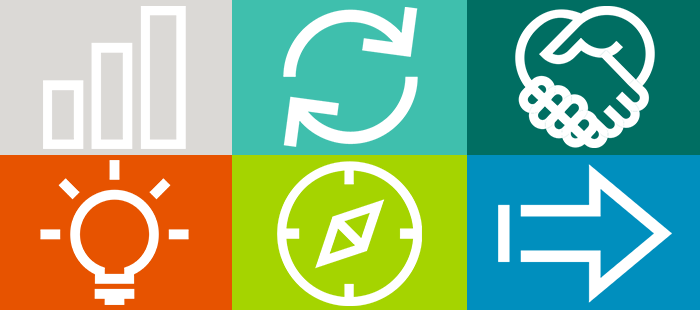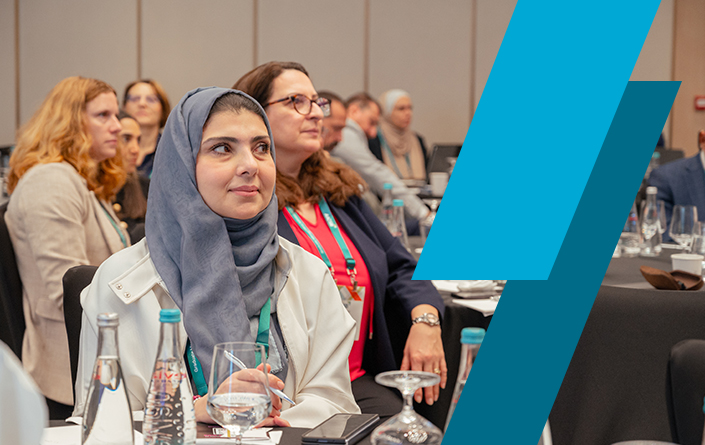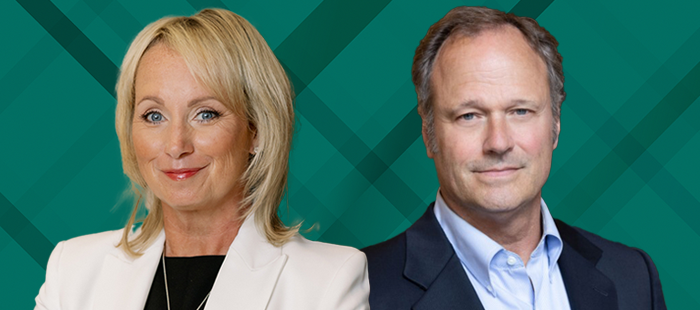ICYMI: Insights on Accreditation
- To fulfill the requirement of achieving societal impact, schools should identify their strengths, tie their efforts to their missions, and track their progress.
- The new standards encourage business schools to collaborate with other disciplines and institutions to develop solutions to society’s grand challenges.
- To develop effective assurance of learning processes, schools must do more than gather relevant data; they must act upon it to continually improve their programs.
Schools pursuing AACSB accreditation are sometimes overwhelmed by the sheer amount of information they must gather and organize, then present in a compelling fashion. For many, a good place to start is to learn how other member schools have implemented the newest accreditation standards, while addressing challenges and avoiding pitfalls. In the past few years, we’ve detailed many of their stories AACSB Insights.
For instance, two years after the 2020 standards were adopted, the association’s chief accreditation officer, Stephanie Bryant, offered an update in “New Report Tracks the State of Accreditation.” At the time, she noted that members were making excellent progress in enhancing engagement and partnership opportunities, funding and incentivizing faculty research, and gathering input from advisory boards in areas such as curriculum and technology. Schools were doing less well at crafting assurance of learning programs, aligning their missions with their scholarship, and solidifying their societal impact plans.
Today, more schools are exhibiting greater confidence in their societal impact strategies, and they are considering new ways to develop partnerships and organize data. Whether you’re planning for the process or seeking out inspiration, the 12 articles we highlight here offer a quick review of best practices in seeking or maintaining accreditation.
It’s All About the Impact
While business schools have enthusiastically embraced the new emphasis on societal impact, many continue to look for more suggestions about how to incorporate it into their operations.
One of the first steps is for school leaders to gain clarity about their goals, as Björn Kjellander, Kathleen Riach, Göran Lindqvist, and Benjamin Stévenin note in “Anchoring Impact to Identity.” They urge administrators to devise mission-driven answers to three questions: “Why does the school want to achieve a certain impact? How can it demonstrate that desired impact? And for whom? Which constituencies will benefit most from the business school’s work?” Schools should base their initiatives on their existing strengths and capacities, they write. “To achieve true societal impact over time, schools must know where they are coming from and be true to who they are.”
AACSB’s Bryant explores this idea more fully in “Moving Toward Transformational Impact.” She writes, “A school cannot simply report a laundry list of good things it is doing and spin those activities into a story. It needs to pick a strategy, build activities around it, and demonstrate the results of its efforts.”
While teaching, research, and engagement activities all lead to outputs, she continues, outputs alone do not satisfy AACSB accreditation requirements. “If we count just the number of journal publications without connecting those activities to impact, we will have a system that encourages meaningless churning instead of a system that fosters outcomes with demonstrable impact. Instead, we should expect a school’s focused activities to result in specific outputs that create measurable outcomes, which in turn lead to meaningful change and demonstrable impact. Over time and through cumulative years of effort, meaningful change can lead to the transformation of an ecosystem.”
A school can track its efforts toward bringing about positive change by creating a Societal Impact Canvas that highlights nine strategic areas.
But how can a school track its efforts toward bringing about positive change? In “Operationalizing Societal Impact,” Samantha Steidle and Dale A. Henderson encourage academic leaders to create a Societal Impact Canvas. Based on the Business Model Canvas created by Alex Osterwalder and Yves Pigneur in 2010, the Societal Impact Canvas is a one-page roadmap that highlights nine strategic areas. “These nine boxes represent the essential building blocks of a business: key partners, key activities, key resources, cost structure, value proposition, customer relationships, distribution channels, customer segments, and revenue streams.”
Other authors share how their own schools have brought societal impact into their operations. For instance, in “A Path to Authenticity and Purpose,” Rumina Dhalla outlines how the University of Guelph’s Gordon S. Lang School of Business and Economics in Ontario, Canada, made sustainability an integral part of its mission and global reputation. “The key to success, we have found, is to embrace sustainability in ways that leverage our strengths, create sustainable value for our stakeholders, and are authentic to our school’s mission,” she writes.
Dhalla suggests that administrators take steps such as finding faculty champions, raising external visibility, reaffirming internal identity, and seeking out collaborators. She recommends that schools use the United Nations Sustainable Development Goals (SDGs) as a framework for identifying gaps and assessing strengths. She adds, “Schools also could leverage existing expertise on campus related to particular SDGs, collaborate with other faculties or centers or campus, or engage with potential industry partners for research and active learning.”
In “Where Thought Leadership Meets Societal Impact,” Sue Lehrman describes how Rowan University’s Rohrer College of Business in Glassboro, New Jersey, recently intensified its focus on achieving positive societal transformation. The school first formed two task forces to tackle issues of thought leadership and societal impact. These ultimately evolved into two centers of excellence, one focused on innovation and entrepreneurship and one on responsible leadership.
For other schools looking for ways to integrate societal impact into their operations, Lehrman advises administrators to revise their missions, systemically tackle their plans, identify champions, develop a clear strategy, document outcomes, and tell a compelling mission-driven story. “Most of all,” she says, “enjoy the process!”
The Power of Partnerships
In addition to emphasizing the importance of societal impact, the new standards promote the value of academic collaboration in its many forms.
For instance, the new structure makes it less cumbersome for schools to pursue more partnerships, as Bryant and Joseph DiAngelo discuss in “How the 2020 Standards Promote Collaboration.” To encourage partnerships between institutions, the recent standards allow for partner schools to be excluded from the scope of accreditation. To encourage partnerships within institutions, the 2020 standards embrace interdisciplinary and cross-disciplinary work within AACSB-accredited schools.
“If business education is to be a player in solving some of society’s grand challenges, it will not be through siloed discipline-specific work. It will be through thoughtful and innovative partnerships between and within institutions,” state Bryant and DiAngelo.
AACSB’s new accreditation structure makes it less cumbersome for schools to pursue partnerships both between and within institutions.
The association is also looking for more ways to enable joint accreditation between AACSB and other organizations, an idea that is visited in “Joining Forces to Reduce Accreditation Fatigue.” AACSB’s Marine Condette outlines three ways that multiple accrediting agencies can work together: Other organizations can recognize AACSB accreditation as a substitute for national accreditation; such organizations can use AACSB reports or accreditation status to prove quality; and other accrediting bodies can partner with AACSB to coordinate accreditation visits.
Condette cautions that joint visits require a great deal of planning and coordination, because procedures and standards will usually differ between groups. However, she notes, “volunteers generally have had very positive reactions.”
The Data Demonstration
But successful accreditation efforts extend beyond implementing societal impact plans and finding the perfect partners. Another essential component is tracking how well students are learning—and using that knowledge to revise program offerings. In fact, as Karen Tarnoff points out in “How to Make Sure an AoL System Is Working,” a robust assurance of learning process “is one of the most critical tasks a school can undertake to ensure continuous improvement.”
Even so, some administrators view AoL as a data collection process rather than a data use process, and so they fail to act on the data they collect. If schools are not actually using AoL activities to adjust their programs, she notes, they will neither meet accreditation standards nor succeed in continuous improvement efforts.
Tarnoff suggests that administrators who need more guidance on AoL processes can register for events hosted by AACSB or watch AACSB’s new video series about common mistakes that schools make in the AoL process.
Faculty and administrators also might consider improving their AoL strategies by “Involving Students in Assurance of Learning,” as Frank Ulbrich did through two different activities. For instance, in a project management course, Ulbrich defined learning goals at the granular level, wrote each one on an index card, and asked students to group them by which ones were logically related. When students put cards such as “close a project” and “produce a final report” in the same pile, they showed that they understood that both of these tasks were part of the project manager’s role.
Ulbrich also asked students to use a four-point Likert scale to assess the importance of each goal. He quickly learned which topics students considered core to the course, and which ones he needed to explain better so students understood their relevance.
If schools are not actually using AoL activities to adjust their programs, they will neither meet accreditation standards nor succeed in continuous improvement efforts.
But AoL measures won’t be possible without robust data collection processes, a topic addressed in “A Dynamic Strategic Plan Doubles Down on Data.” Rena Keath and Melissa Beaven describe how the Gatton College of Business and Economics at the University of Kentucky in Lexington put together a College Enhancement Unit that acts as a “one-stop shop” for all essential data at the school.
Business officers can use the data to generate financial reports, academic program directors can access reports related to admissions and enrollments, and administrators can look at historical patterns. Just as important, accreditation officers can organize the data required by various accrediting bodies, which often have their own timeframes and data submissions requirements.
According to Keath and Beaven, “The new system allows users to create different data dashboards for each purpose, allowing for more efficient processes, richer data mining, and easier modifications to meet different reporting guidelines.”
At the Ready
Once schools have identified their missions, aligned their strategic initiatives, and collated their data, they’re finally ready for the arrival of peer review teams. In “Are You Prepared for Your Accreditation Visit?” Ira Weiss encourages school leaders to create a focused mission statement, align faculty qualifications with the mission, and never lose sight of key metrics.
Weiss also advises school accreditation teams to establish a continuous process of measurement so they can evaluate how they are faring against the standards and take any necessary corrective action—which will prevent surprises during the next PRT visit.
Schools that monitor their progress on an ongoing basis, keep track of relevant data, and map their activities to the standards will be prepared for the challenges of pursuing and maintaining accreditation. And at AACSB Insights, we’ll continue to provide updates on what schools are doing to meet those challenges.






